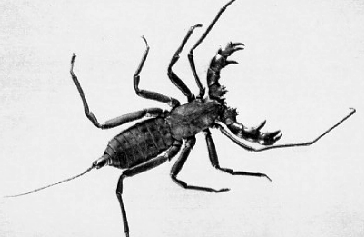
Consulting Entomologist

Tel/Fax: 01275 854224
E-Mail: [email protected]
Site Guide
Site Search
Home Page
Career Page
Insect Files
- Contents
- Bug Index
- The World of Bugs
- Classification of Bugs
- Insect Identification
- Insect Fossils
- Insect Body-parts
- Micro View of Bugs
- Insect Life Cycles
- Insect Defences
- Insects of Nailsea
- Pesticide Safety
- Bibliography
Shortcut to the main groups of insects and other arthropods...
Bug Rhymes & Poems
Links
Shop
Payments (credit/debit card)
Whip Scorpions |
Class: Arachnida Order: Pedipalpi |
| Scorpion-like but no sting in the tail . . . . . . | |
 Hypoctonus rangunensis (a whip scorpion from southern Burma) body length, excluding the tail, up to 3-4 cm Photo: V.J. Stanek © |
The whip scorpions have a life pattern similar to the true scorpions, but they do not possess a poisonous sting. Their flat body enables them to squeeze into extremely narrow cracks and crevices, where they prey on small arthropods and worms. A few of the larger species also attack small vertebrates, especially frogs. The palps are developed into strong pincers equipped with sharp teeth and spines, which are used for catching and crushing prey. The first pair of legs are generally much longer and thinner than the other three pairs, and may have more a tactile function rather than walking. The species shown opposite belongs to the family Theliphonidae, whose members have a characteristic long, thread-like tail. The tail, which bears numerous fine hairs, has only a sensory function, but can be waved about in a whip-like manner - hence the common name. Although whip scorpions are not poisonous, some species defend themselves by squirting an acrid fluid from defence glands situated at the base of the tail. |
|
In the other families of the order, the tail is much reduced or absent altogether - these forms are sometimes called whip spiders, rather than whip scorpions. The group as a whole is largely confined to the tropics and sub-tropics, but nevertheless widely distributed with representatives found in China, Japan, India and other parts of Southern Asia, the greater part of Africa, and in Central and South America. |
|
|
RELATED PAGES (Other Arachnida) | ||||
|
FALSE SCORPIONS (Pseudoscorpiones) |
KING CRABS (Xiphosura) |
WHIP SCORPIONS (Pedipalpi) | ||
|
SCORPIONS (Scorpionidea) |
HARVESTMEN (Opiliones) |
MITES (Acari) |
WIND SCORPIONS (Solifuga) |
SPIDERS (Araneae) |
 (classification of arachnids) |
| <<< TOP | (use the back button on your web browser to return to the previous page) | TOP >>> |